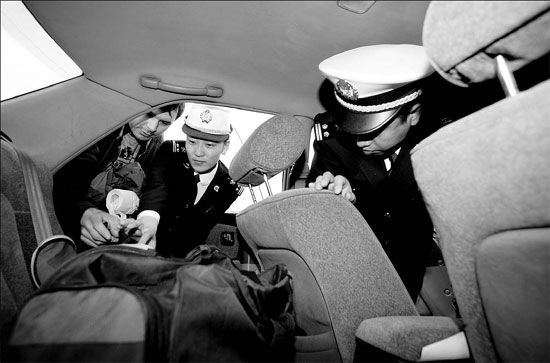Emerging markets charge to the front
Updated: 2013-03-04 07:51
By Li Jiabao (China Daily)
|
||||||||
|
Two Chinese customs officials checking a Russian businessman's luggage inside a car at Manzhouli port. China's trade and economic cooperation with its traditional markets such as the European Union, Japan and the United States are declining, while that with emerging markets is gaining more importance. Provided to China Daily |
Business with traditional partners is proportionately in decline: Analysts
Emerging markets are gaining more weight in China's foreign trade as the country diversifies its business partners and the dismal world economy takes its toll on developed economies.
"China must make more efforts to adjust its export destinations and increase shipments to Asia, Africa and Latin America. The traditional partners, such as the European Union, Japan and the United States, are not doing well. Chinese products are still competitive in emerging markets," said Zhuang Jian, a senior economist with the Asian Development Bank.
Jin Baisong, deputy director of the Department of Chinese Trade and Studies at the Chinese Academy of International Trade and Economic Cooperation, a think tank affiliated with the Ministry of Commerce, agreed that emerging markets are now striking regions for China's foreign trade because of promising growth prospects and rising trade opportunities in these economies.
Foreign trade in the world's second largest economy rose 6.2 percent year-on-year in 2012 to $3.87 trillion, contrasting with a 22.5 percent surge in 2011, according to the General Administration of Customs.
"China's foreign trade presented a more remarkable feature in partner diversification in 2012. Trade with traditional partners accounts for a shrinking share in China's overall trade while that with Association of Southeast Asian Nations and emerging markets is gaining more importance," said customs spokesman Zheng Yuesheng in a news briefing in January.
The proportion of traditional markets, including the European Union, Japan and the United States, in China's total trade dropped 2.1 percent in 2012 from a year earlier. Meanwhile, emerging markets and ASEAN saw their share in Chinese trade rise 0.8 percent last year, Zheng said.
Trade with the EU, China's largest trade partner, declined 3.7 year-on-year in 2012 while trade with Japan, the fifth trade partner, was down 3.9 percent. In contrast, bilateral trade with ASEAN, China's third largest trade partner, jumped 10.2 percent year-on-year in 2012 and that with Russia grew 11.2 percent, according to the customs data.
China now attaches more importance to exports to emerging markets, especially other members of BRICS (Brazil, Russia, India, China and South Africa), according to a recent report from Standard Bank Group.
"Seven of China's top 10 trade partners are emerging markets," said the group's economist, Jeremy Stevens. "Exports to BRICS markets are especially important. They reflect the fact that China plays a more important role in BRICS. China acts as a counterparty in 85 percent of intra-BRICS trade flows."
China ranks as a top three export destination for Brazil, Russia, India and South Africa.
Moreover, Brazil, Russia, India, China and South Africa trade more with Africa than they do among themselves. BRIC-Africa trade will exceed $500 billion by 2015, roughly 60 percent of which - $300 billion - will consist of China-Africa trade, according to the report.
Africa is likely to overtake the EU and the US to become China's largest trade partner in three to five years, given the current growth pace, said Wei Jianguo, vice-chairman and secretary-general of the China Center for International Economic Exchanges, a high-level government think tank.
Meanwhile, China is speeding up the opening-up of border areas to develop a new driving force for trade growth.
lijiabao@chinadaily.com.cn

 In Photos: 7.0-magnitude quake hits Sichuan
In Photos: 7.0-magnitude quake hits Sichuan
 Li Na on Time cover, makes influential 100 list
Li Na on Time cover, makes influential 100 list
 FBI releases photos of 2 Boston bombings suspects
FBI releases photos of 2 Boston bombings suspects
 World's wackiest hairstyles
World's wackiest hairstyles
 Sandstorms strike Northwest China
Sandstorms strike Northwest China
 Never-seen photos of Madonna on display
Never-seen photos of Madonna on display
 H7N9 outbreak linked to waterfowl migration
H7N9 outbreak linked to waterfowl migration
 Dozens feared dead in Texas plant blast
Dozens feared dead in Texas plant blast
Most Viewed
Editor's Picks

|

|

|

|

|

|
Today's Top News
Live report: 7.0-magnitude quake hits Sichuan, heavy casualties feared
Boston suspect cornered on boat
Cross-talk artist helps to spread the word
'Green' awareness levels drop in Beijing
Palace Museum spruces up
First couple on Time's list of most influential
H7N9 flu transmission studied
Trading channels 'need to broaden'
US Weekly

|

|








